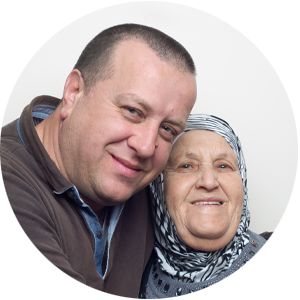Eye treatments we offer
Eye treatments
We make it easy to get the help you need
Diabetic retinopathy treatment
Systemic control of diabetes, hypertension, hyperlipidemia, nephropathy and other diseases are of paramount importance.
Medical therapy and follow up
Treatment of macular edema is usually needed in order to prevent loss of vision or to try to improve vision. Treatment includes the use of lasers or injection of drugs that cause the retinal swelling/macular edema (from leaking blood vessels) to resolve. Patients are seen monthly if being injected or every 3 months post-laser for macular edema. (DRCR, RIDE, RISE, DAVINCI and ETDRS studies). Several studies indicate that anti-VEGF drugs are more effective than focal laser (DRCR, READ2, RIDE, RISE, DAVINCI). A recent study by the DRCR network has shown all three drugs (bevacizumab, ranibizumab and aflibercept) are effective for macular edema therapy.
Treatment of PDR is laser photocoagulation of the peripheral retina/panretinal photocoagulation (PRP). The laser is used to create scars on the peripheral retina. If successful, vitreous bleeding may be averted. Sometimes the proliferative disease is advanced and there is bleeding filling the eye (and preventing laser to be done) or scar tissue that wrinkles the retina or pulls it off the eyewall surface. In these situations, surgery is necessary (see vitrectomy for more information). In cases of NVD/ NVE with NVI, anti-VEGF injections into the eye can also be used. DRCR protocol S showed that anti-VEGF drug ranibizumab was noninferior to PRP in PDR. Anti-VEGF injections are sometimes used in concert with laser when rubeosis and neovascular glaucoma are present. Anti-VEGF are also given prior to vitrectomy surgery in selected cases.
Surgery and surgical follow up
The goal of surgery is to remove blood and scar tissue from the retinal surface and to place laser treatment as needed. Intraoperatively, intraocular gas or silicone oil may be needed to reattach the retina to the underlying layers and eyewall.
Learn more about this condition.
Age-related Macular Degeneration treatment
Occasionally, macular holes may resolve without treatment. However, we recommend you see an ophthalmologist immediately if you notice a sudden loss of vision in one eye so that they can determine if treatment is necessary. Early diagnosis is essential to help prevent permanent vision loss.
The most common treatment for macular holes is a surgery called vitrectomy. Vitrectomy is a process that removes the vitreous gel to prevent it from pulling on the retina. Next, we insert a mixture of air and gas into where the vitreous once was, putting pressure on the macular hole, allowing it to heal.
This treatment requires a lengthy recovery period to ensure lasting results.
Learn more about this condition.
Retinal detachment treatment
Once a retinal detachment has been identified, one must determine what type of detachment is present. Surgical management is indicated for rhegmatogenous and tractional detachments.
For rhegmatogenous detachments, all retinal breaks should be identified, treated and closed. Techniques for repair include pneumatic retinopexy, scleral buckle or vitrectomy, or combinations of these techiques.
- Pneumatic retinopexy involves the injection of an intraocular gas bubble along with retinopexy using cryotherapy or laser., typically in a clinic setting. An important part in the successful repair of retinal detachment with pneumatic retinopexy involves head positioning so that the gas bubble tamponades the retinal tear. Pneumatic retinopexy is typically only used with retinal detachments due to retinal tears in the superior eight clock hours and involving a single break less than one clock hour., although exact criteria are controversial and largely depend on surgeon and patient factors.
- Scleral buckles are silicone bands permanently placed around the outside of the globe under the extraocular rectus muscles to relieve any traction and support retinal tears. Scleral buckling is combined with retinopexy, typically cryotherapy. This is the oldest method of repair and still has excellent results in well-trained hands. This procedure is performed in the operating room.
- Pars plana vitrectomy with 20 gauge, 23 gauge, 25 gauge, or 27 gauge instruments involves removal of the vitreous by way of cutting the vitreous strands with a vitrectomy machine/handpiece and flattening of the retina through a direct intraocular process.
In tractional detachments, tractional elements (usually epiretinal or subretinal membranes) must be relieved. This is typically accomplished with pars plana vitrectomy, but may be combined with scleral buckling as an adjunct.
For serous detachments, management is nonsurgical. Any inflammatory disease or underlying mass should be identified and treated if possible.
Learn more about this condition.
Other eye treatments
We make it easy to get the help you need
Eye allergies treatment
Many different types of medical treatments for eye allergies are available by prescription. Your ophthalmologist may prescribe eye drops to treat certain eye conditions, infections or diseases.
Before using eye drops, you should inform your ophthalmologist if you are taking any other prescription or nonprescription medications. You should also inform them of any allergies that you have.
Cataract surgery treatment
New advances and techniques have made cataract surgery one of the most successful and life-improving surgical procedures performed. We offer the latest procedures available to help remove cataracts and restore your vision, including the placement of intraocular lenses. Most cataract surgeries are performed on an outpatient basis, and more than 95% of surgeries improve vision.
Chalazion treatment
Use warm compresses for 10-15 minutes on the chalazion, 2-4 times a day to help reduce swelling. If after 3-4 days the swelling hasn’t subsided, contact your ophthalmologist.
You should contact your ophthalmologist immediately if you experience any of the following symptoms:
- Headache
- Fever
- Blurred or decreased vision
- Drainage
- Extensive swelling and redness
- Both eyes and eyelids are swollen
Dry eye treatment
Depending on the cause and extent of dry eye syndrome, it may or may not be able to be completely cured. Even when not cured, however, the symptoms can be managed.
Restasis eye drops
One of the treatments for dry eye syndrome is Restasis eye drops. These are a prescription artificial tear formula that contains materials that not only lubricate and comfort the eye but also encourage the eye to produce more tears.
Lacrimal plug
Another possible treatment is the installation of lacrimal plugs, also called punctal plugs. The plugs are inserted into the tear ducts, to stop tears from draining off the surface of the eye too quickly.
Surgery
In more extreme cases, we may have to close the tear ducts surgically.
Preventative measures
If dry eyes are a result of your environment – for example dry or dusty conditions at work – it may be helpful to wear sunglasses or to use a humidifier.
Nutritional insufficiencies can also be to blame for dry eyes, in which case we advise you to take dietary supplements or to drink more water.
Glaucoma treatment
While there is no cure for glaucoma, many medications and procedures exist that can help to slow the disease or stop it altogether. However, like so many eye-related disorders, early diagnosis is essential. Because the early stages of glaucoma have no noticeable symptoms, we recommend regular eye exams for everyone, even if you have no eye-related symptoms or problems.
Strabismus/lazy eye treatment
Early treatment is strongly advised for children with strabismus because it is not a condition that children “grow out of”. Some conventional treatments for strabismus include optical devices, vision and muscle therapy, and, as a last resort, surgery.
Discover your options to get your eyes back in top shape
Call us and we’ll help you take the steps you need to repair your eyes
Treatment of common vision problems
We make it easy to get the help you need
Astigmatism treatment
Refractive disorders (like astigmatism) are commonly treated with corrective lenses, whether it be eyeglasses or contact lenses. However, some refractive disorders require refractive surgery.
Keratoconus treatment
Mild corneal disorders like keratoconus are commonly treated with corrective lenses, whether it be eyeglasses or contact lenses. Alternative treatments for more severe cases include corneal cross-linking or corneal transplant.
Farsightedness treatment
Refractive disorders like farsightedness are commonly treated with corrective lenses, whether it be eyeglasses or contact lenses. However, some refractive disorders require refractive surgery.
Nearsightedness treatment
Refractive disorders like nearsightnedness are commonly treated with corrective lenses, whether it be eyeglasses or contact lenses. However, some refractive disorders require refractive surgery.
Treatment
Refractive disorders like presbyopia are commonly treated with corrective lenses, whether it be eyeglasses or contact lenses. However, some refractive disorders require refractive surgery.
Cosmetic eye treatments
We make it easy to get the help you need
Botox
As a cosmetic procedure, there are a few well-known and proven techniques as Botox.
How does it work?
Botox is essentially a relaxer. When we inject it near a muscle group, it blocks specific electrical signals that cause the muscles to contract. As a result, the muscle relaxes and wrinkles in the skin smoothen out. Botox is especially effective for muscle groups around the eyes that cause “crow’s feet”, and between the eyes and on the forehead.
Risks and side effects
Botox is simple, safe, fast and effective, especially when administered by a medical professional. No sedation or anaesthetic is required, and you can resume your normal daily activities immediately after treatment.
How long do results last?
Botox results typically last for several months.
Blepharoplasty
Blepharoplasty is a cosmetic surgical procedure on the eyelids that can significantly improve the appearance of the upper or lower eyelid.
We make small incisions to redistribute or remove fat deposits, tighten muscles and remove excess skin layers. We make the incisions in very deliberate areas that are concealed by the natural folds of the eyelids. As a result, the incisions are barely noticeable or not noticeable at all.
Risks and side effects
You may experience some slight swelling and bruising, dry eyes and minor discomfort after the surgery.
The results
The results of the procedure are immediately noticeable.
Collagen
Collagen, as well as other natural or artificial dermal fillers, is commonly used to reduce the appearance of wrinkles in the skin.
When our skin’s natural amounts of collagen begin to break down, the skin becomes thinner, more brittle, and the loss of fat deposits causes creases and wrinkles. With dermal filler injections, those areas of weakened collagen or fat deposits can be restored, returning a healthy smoothness to the skin. For ophthalmologists, this is particularly important for areas around the eyes, where a loss of collagen can cause a “sunken-in” look.
Results, risks and side effects
Collagen and dermal filler injections can be a safe, effective way for eyes to look younger and healthier, and the procedure requires little recovery time.
Discover your options to get your eyes back in top shape
Call us and we’ll help you take the steps you need to repair your eyes
How to get help
These 3 easy steps allow you to stop worrying about your eyes
STEP 1:
Call us to get an appointment
Give us a call at (718) 630-1010 and we’ll answer the questions you have so that we can recommend the best next step.
STEP 2:
Visit us
Whatever the issue, we’ll provide you with the exceptional care that your most precious sense deserves.
STEP 3:
Get the help you need
Whether it’s a quick intervention or a long-term treatment plan, we’ll guide you with compassion, every step of the way.
Affiliations and memberships
We are proud to be associated with these professional organisations
A comprehensive Brooklyn and ManhattanEye Clinic
Looking for treatment for a particular eye problem? Find more information below:
What our patients say
★★★★★
We’ve been getting 5-star reviews from savvy Brooklynites and New Yorkers for over 20 years


Dr.Khosrof is one of the most knowledgeable doctors in his field. My family and I have been his patients for years and he has never failed to provide us tip top service and always does what’s safest for us and our eyes…


I want to talk about Dr. Samer, he is extremely professional and kind and he has the latest equipment and great staff. He’s very caring about his patients and takes the time to explain.


Dr. Khosrof is an outstanding physician and surgeon with a great bedside manner. As a fellow Ophthalmologist, I have always been impressed by his talent.


Dr. Khosrof improved my eye sight from 20/400 to 20/80. I had previously see 2 other retina specialists and 1 optometrist and none of them were able to help me. He’s terrific!
About the expert
Dr. Samer Khosrof | Ophthalmologist
Dr. Samer Khosrof is a top eye surgeon in New York City with over 25 years of experience treating complex eye conditions such as diabetic retinopathy and age-related eye conditions.
His extensive experience enables him to stay on top of the latest treatments available. He believes in the efficacy of medical technology and has the expertise to deploy the newest diagnostic and treatment techniques to treat his patients with 100% confidence.
When you become a New York Eye & Retina Clinic patient; you’re a Samer Khosrof patient first. This means he sees you before your surgery, he performs your surgery, and he provides your aftercare. In the end, you’re his patient, and he takes that responsibility very seriously.
































